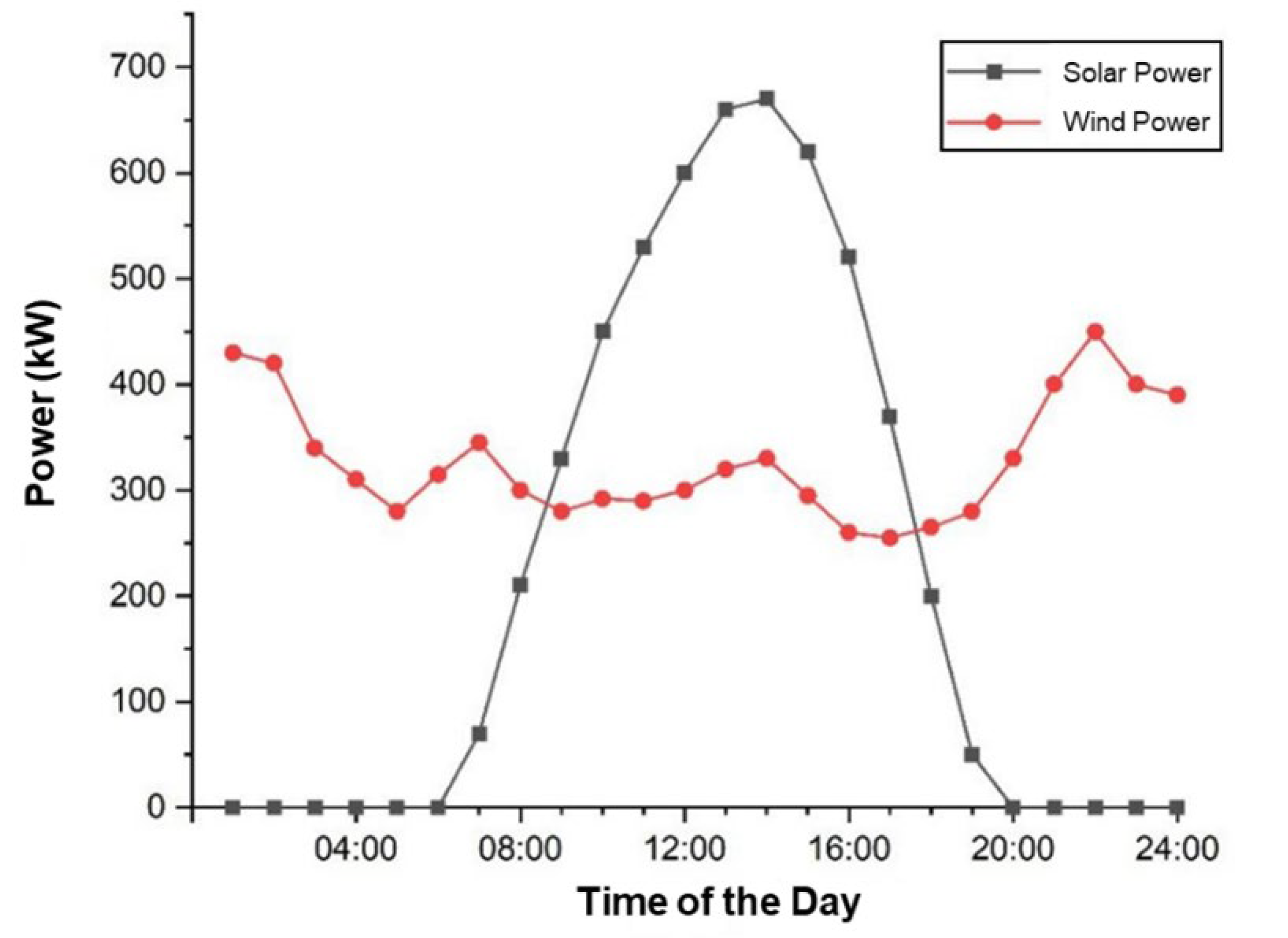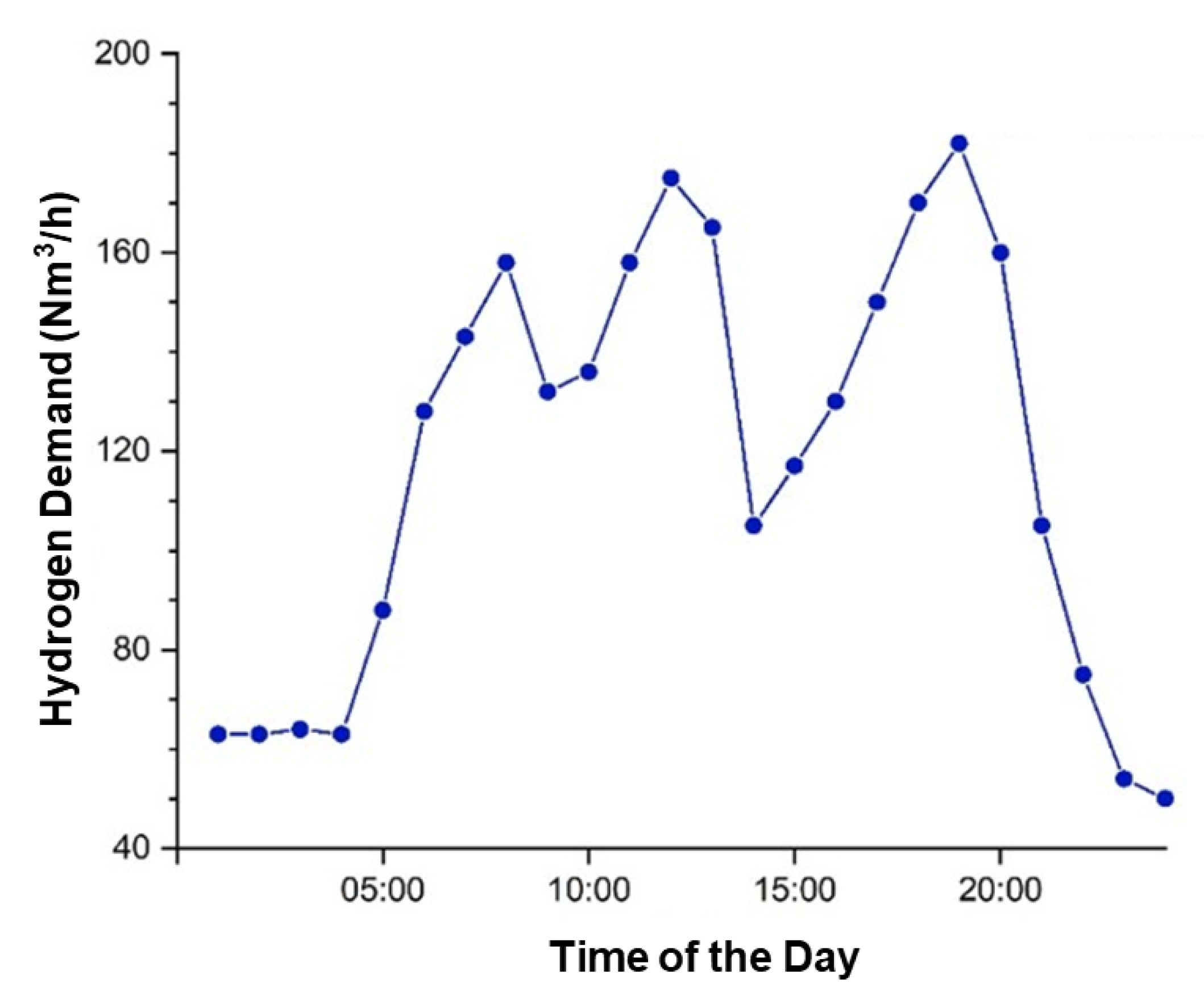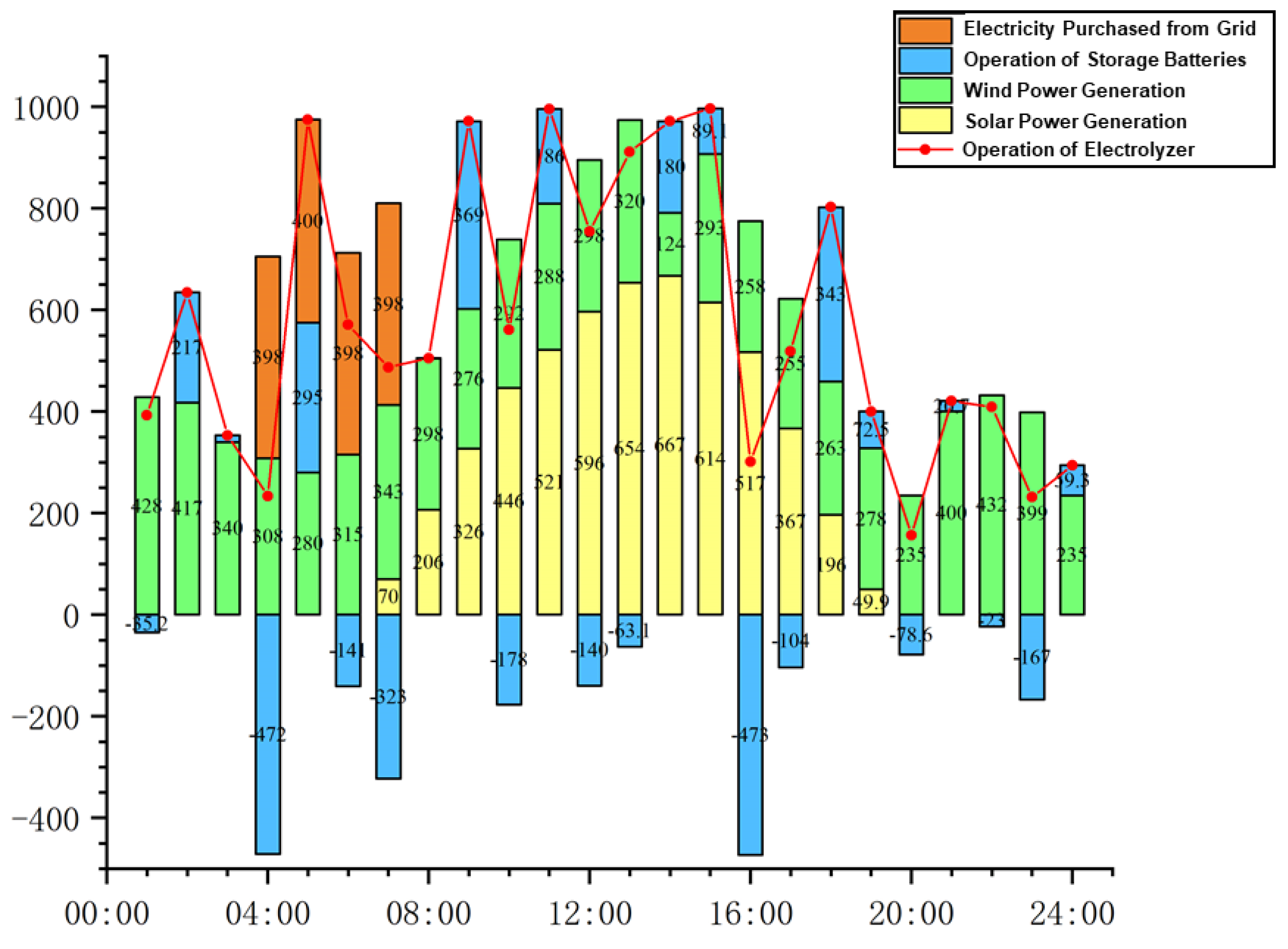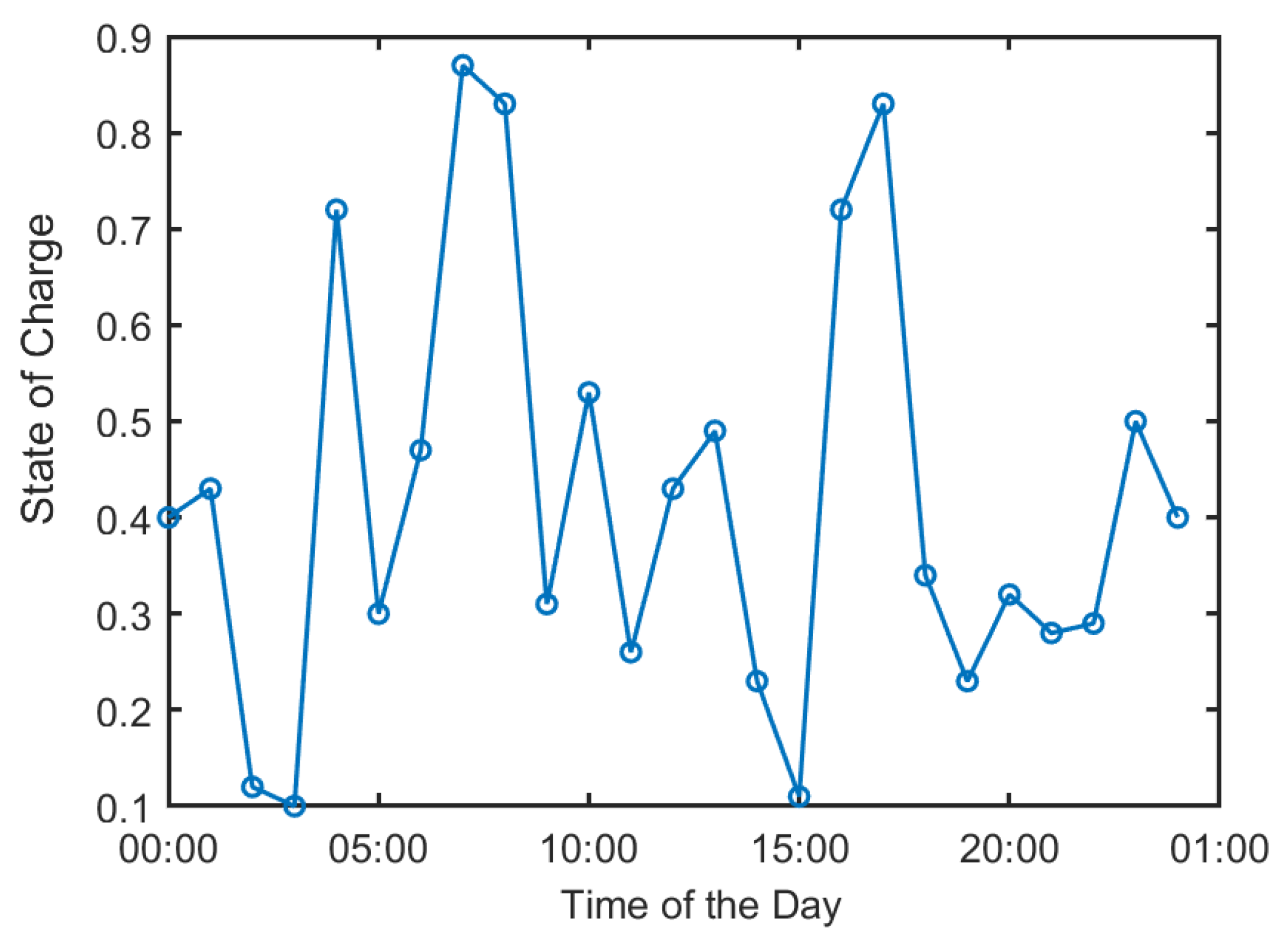Day-Ahead Operation Analysis of Wind and Solar Power Generation Coupled with Hydrogen Energy Storage System Based on Adaptive Simulated Annealing Particle Swarm Algorithm
Abstract
:1. Introduction
2. Structure and Mathematical Model of Wind and Solar Power Generation Coupled with Hydrogen Energy Storage System
2.1. Structure of System
2.2. Mathematical Model
2.2.1. Photovoltaics Model
2.2.2. Wind Power Generation Model
2.2.3. Storage Battery Devices
2.2.4. Alkaline Electrolyzer
3. Day-Ahead Scheduling Optimization Model for Wind and Solar Power Generation Coupled with Hydrogen Energy Storage System
3.1. Targeted Function
3.2. Constraint Conditions
4. Adaptive Simulated Annealing Particle Swarm Optimization Algorithm
5. Calculation Example Analysis
5.1. Calculation Example Parameters
5.2. Result Analysis of Calculation Example
5.2.1. Day-Ahead Operation Plan for System and State of Capacity of Power Storage Devices
5.2.2. System Operation Cost Analysis
5.2.3. Algorithm Comparison
6. Conclusions
- (1)
- When building a day-ahead operation optimization model for wind–solar power generation coupled with hydrogen energy storage with the goal of minimizing the daily operation cost, the hydrogen demand could be met, and the economic efficiency of operating the system could be improved via coordinative scheduling among the hydrogen-producing devices, storage batteries, and electricity purchases from the grid.
- (2)
- An analysis of the calculation example showed that storage batteries played the role of peak cutting, and their capacity might impact the consumption of wind and solar power by the system.
- (3)
- Compared to the standard PSO algorithm, the improved ASAPSO algorithm was more effective and showed better performance at jumping out of the local optimal solution and finding the global optimal solution, which helped save 28% of the daily operation cost of the system. Therefore, the optimization of the day-ahead operation plan for the wind–solar power generation coupled with a hydrogen energy storage system could significantly improve the economic efficiency of the system’s operation.
Author Contributions
Funding
Conflicts of Interest
References
- Wan, J. Renewable Energy: How to Achieve the Orderly Replacement of Fossil Fuel Energies. World Knowl. 2021, 23, 20–22. [Google Scholar]
- Li, X.; Shao, Z. An Economic Optimal Scheduling Model for a Multi-energy Complementary Power Generation System with Multiple Energy Storage. In Proceedings of the 2021 IEEE 7th International Conference on Control Science and Systems Engineering (ICCSSE), Qingdao, China, 30 July 2021. [Google Scholar]
- Huang, Y.; Hu, W.; Chen, L. Day-ahead generation scheduling plan modes for large-scale wind-storage combined power generation system based on two-stage optimization. Autom. Electr. Power Syst. 2015, 39, 8–15. (In Chinese) [Google Scholar]
- Yi, L.; Zhang, Y.R.; Li, Y.; Zhang, J.; Zong, Z.D.; Xiang, W.P.; Liu, Y.L. Scheduling Optimization of Power Generation System with Wind Energy for Low-Carbon Economy. Water Resour. Power 2018, 36, 157, 213–216. [Google Scholar]
- Chen, A.J. Technological Features and Application Outlook of Hydrogen Energy Storage. China Sci. Technol. 2021, 19, 120–121. [Google Scholar]
- Yang, J.G.; Liu, W.M.; Li, S.X.; Deng, T.H.; Shi, Z.P.; Hu, Z.C. Optimization Operation Strategies and Efficiency Analysis of Wind Power Generation Coupled with Hydrogen Energy Storage. Electr. Power Constr. 2017, 38, 106–115. [Google Scholar]
- Liu, Y.J.; Fan, Y.F.; Hao, J.W.; Bai, X.; Song, Y. Capacity Configuration and Optimal Scheduling of a Wind-Photovoltaic-Hydrogen-Thermal Virtual Power Plant Based on a Wide Range Power Adaptation Strategy for an Alkaline Electrolyzer. Power Syst. Prot. Control 2022, 50, 48–60. [Google Scholar]
- Ge, S.Y.; Guo, J.Y.; Liu, H.; Zeng, P.L. Impacts of electric vehicle’s ordered charging on power grid load curve considering demand side response and output of regional wind farm and photovoltaic generation. Power Syst. Technol. 2014, 38, 1806–1811. (In Chinese) [Google Scholar]
- Ding, S.Y.; Lin, X.N.; Chen, Z.; Wang, Z.; Zhang, Z. A Design and Dispatch Strategy of Storage-hydrogen-cooling Combined Renewable Energy Absorption Facility on Rich Resource Island. Proc. CSEE 2019, 39, 4659–4673, 4969. [Google Scholar]
- Gao, J.; Zou, B. Economic Optimization Dispatch of Microgrid based on Particle Swarm Algorithm. Electron. World 2019, 20, 21–26. [Google Scholar]
- Shang, Q.X.; Sun, M. Optimal Dispatching of Power Grid based on Wind Power and Heat Storage Heating System. J. Sol. Energy 2021, 42, 65–70. [Google Scholar]
- Chai, G.A.; Wu, J.H.; Yao, L.; Zhang, Q. Operation Optimization of Combined Cooling, Heating and Power Microgrid Based on Improved Dynamic Inertia Weighted Particle Swarm Algorithm. Sci. Technol. Eng. 2022, 22, 1472–1479. [Google Scholar]
- Lu, J.; Yu, L.J.; Zheng, P.; Hou, S.Y. Super-Ahead Control Strategy of Wind-Hydrogen Coupled System. Acta Energ. Sol. Sin. 2022, 43, 53–60. [Google Scholar]
- Shao, Z.; Wu, J. Capacity Configuration Optimization of Hydrogen Production from Wind and PV Power Based on Dynamic Electricity Price. Acta Energ. Sol. Sin. 2020, 41, 227–235. [Google Scholar]
- Yuan, T.J.; Wan, Z.; Wang, J.J.; Zhang, T.; Jiang, D.F. Day-Ahead Power Generation Plan for Hydrogen-Producing System with Start and Stop Features of Electrolyser Considered. Electr. Power 2022, 55, 101–109. [Google Scholar]
- Zhang, G.; Wang, W.; Du, J.; Liu, H. A Multi-Objective Optimal Operation of a Stand-Alone Microgrid Using SAPSO Algorithm. J. Electr. Comput. Eng. 2020, 2020, 6042105. [Google Scholar]
- Shadmand, M.B.; Balog, R.S. Multi-Objective Optimization and Design of Photovoltaic-Wind Hybrid System for Community Smart DC Microgrid. IEEE Trans. Smart Grid 2014, 5, 2635–2643. [Google Scholar] [CrossRef]
- Maleki, A. Optimal Operation of a Grid-Connected Fuel Cell based Combined Heat and Power Systems using Particle Swarm Optimization for Residential Sector. Int. J. Ambient Energy 2019, 42, 550–557. [Google Scholar] [CrossRef]
- Kerdphol, T.; Fuji, K.; Mitani, Y.; Watanabe, M.; Qudaih, Y. Optimization of a Battery Energy Storage System using Particle Swarm Optimization for Stand-Alone Microgrids. Int. J. Electr. Power Energy Syst. 2016, 81, 32–39. [Google Scholar] [CrossRef]
- Maleki, A. Design and Optimization of Autonomous Solar-Wind-Reverse Osmosis Desalination Systems Coupling Battery and Hydrogen Energy Storage by an Improved Bee Algorithm. Desalination 2018, 435, 221–234. [Google Scholar] [CrossRef]
- Li, G.; Zhai, X.; Li, Y.; Feng, B.; Wang, Z.; Zhang, M. Multi-objective Optimization Operation Considering Environment Benefits and Economy Based on Ant Colony Optimization for Isolated Micro-grids. Energy Procedia 2016, 104, 21–26. [Google Scholar] [CrossRef]
- Yan, Q.M.; Ma, R.Q.; Ma, Y.X.; Wang, J. Adaptive Simulated Annealing Particle Swarm Optimization Algorithm. J. Xidian Univ. 2021, 48, 120–127. [Google Scholar]
- Hua, Y.; Zhu, W.; Jin, Y.; Ming, H.; Wang, S.; Jiao, Z. Research on photovoltaic MPPT control based on adaptive mutation particle swarm optimization algorithm. Acta Energ. Sol. Sin. 2022, 43, 219–225. [Google Scholar]
- Chen, K.; Qiu, X.; Shi, G.; Li, X. Time-Scale Decomposition of Energy Storage in Micro-Grid with Renewable Energy. Electr. Meas. Instrum. 2018, 55, 30–34. [Google Scholar]






| Time Types | Specific Periods | Electricity Price |
|---|---|---|
| Valley Time | 0:00–07:00 | 0.308 |
| Regular Time | 07:00–09:00, 11:00–19:00 | 0.594 |
| Peak Time | 09:00–11:00, 19:00–24:00 | 0.88 |
| Parameters | Values | Parameters | Values |
|---|---|---|---|
| /(kW) | 1000 | (kW⋅h) | 800 |
| /(kW) | 150 | /% | 4.6 |
| /(m3/kW⋅h) | 0.25 | /% | 95 |
| /% | 82 | /% | 90 |
| /(kW) | 270 | /% | 10 |
| /(kW) | 270 |
| Parameters | Values |
|---|---|
| /(yuan/(kW⋅h)) | 0.5 |
| /(yuan/(kW⋅h)) | 0.05 |
| /(yuan/Nm3) | 0.21 |
| /(yuan/kW) | 0.03 |
| /(yuan/kW) | 0.04 |
| /(yuan/kW) | 0.23 |
| /(yuan/kW) | 0.23 |
| Parameters | Values |
|---|---|
| Penalty Cost of Wind Energy Waste | |
| Penalty Cost of Solar Energy Waste | |
| Operation Cost of Wind Power Generation System | |
| Operation Cost of Solar Power Generation System | |
| Cost of Purchasing Electricity | |
| Operation Cost of Storage Batteries | |
| Operation Cost of Electrolyzer | |
| Operation Cost of Hydrogen Storage Tanks | |
| Daily Operation Cost |
| Algorithm | Standard PSO | ASAPSO |
|---|---|---|
| Average Targeted Function Values |
Publisher’s Note: MDPI stays neutral with regard to jurisdictional claims in published maps and institutional affiliations. |
© 2022 by the authors. Licensee MDPI, Basel, Switzerland. This article is an open access article distributed under the terms and conditions of the Creative Commons Attribution (CC BY) license (https://creativecommons.org/licenses/by/4.0/).
Share and Cite
Chen, K.; Peng, H.; Gao, Z.; Zhang, J.; Chen, P.; Ruan, J.; Li, B.; Wang, Y. Day-Ahead Operation Analysis of Wind and Solar Power Generation Coupled with Hydrogen Energy Storage System Based on Adaptive Simulated Annealing Particle Swarm Algorithm. Energies 2022, 15, 9581. https://doi.org/10.3390/en15249581
Chen K, Peng H, Gao Z, Zhang J, Chen P, Ruan J, Li B, Wang Y. Day-Ahead Operation Analysis of Wind and Solar Power Generation Coupled with Hydrogen Energy Storage System Based on Adaptive Simulated Annealing Particle Swarm Algorithm. Energies. 2022; 15(24):9581. https://doi.org/10.3390/en15249581
Chicago/Turabian StyleChen, Kang, Huaiwu Peng, Zhenxin Gao, Junfeng Zhang, Pengfei Chen, Jingxin Ruan, Biao Li, and Yueshe Wang. 2022. "Day-Ahead Operation Analysis of Wind and Solar Power Generation Coupled with Hydrogen Energy Storage System Based on Adaptive Simulated Annealing Particle Swarm Algorithm" Energies 15, no. 24: 9581. https://doi.org/10.3390/en15249581






